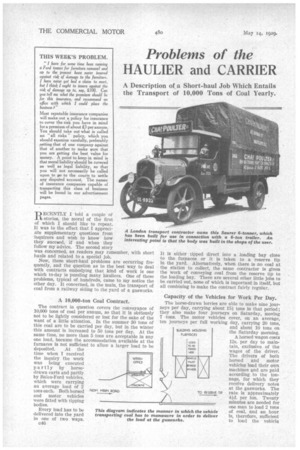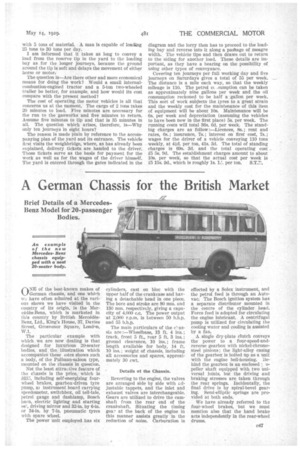Problems of the HAULIER and CARRIER
Page 76

Page 77

If you've noticed an error in this article please click here to report it so we can fix it.
RECENTLY I told a couple of stories, the moral of the first of which I should like to repeat. It was to the effect that I appreciate supplementary questions from inquirers and wish to know how they succoed, if and when they follow my advice. The second story was concerned, as readers may remember, with short hauls and related to a special job.
Now, these short-haul problems are occurring frequently, and the question as to the best way to deal with contracts embodying that kind of work is one which to-day is puzzling many hauliers. One of these problems, typical of hundreds, Came to my notice the other day. It concerned, in the main, the transport of coal from a railway siding to the yard of a gasworks.
A I0,000-ton Coal Contract.
Every load has to be delivered into the yard in one of two ways.
c46 It is either tipped direct into a loading bay close to the furnaces or it is taken to a reserve tip in the yard. Alternatively, when there is no coal at the station to collect, the same contractor is given the work of conveying coal from the reserve tip to the loading bay. There are several other little jobs to be carried out, none of which is important in itself, but all combining to make the contract fairly regular.
Capacity of the Vehicles for Work Per Day.
The horse-drawn lorries are able to make nine jour neys per day, carrying about 151 tons in that period; they also make four journeys on Saturday, moving 7 tons. The motor vehicles cover, on an average,
ten journeys per full working day, carrying 20 tons, and about 10 tons on the Saturday morning.
BUILDING 1-10USING FURNP10ES
A horsed wagon costs 12s. per day to maintain, exclusive of the wages of the driver. The drivers of both horsed and motor vehicles load their own machines and are paid according to the tonnage, for which they receive delivery notes at the gasworks. The rate is approximately 4id. per ton. Twenty minutes are needed for one man to load 2 tons
manner in which the vehicle of coal, and an hour anceuvre in order to deliver is, therefore, sufficient he gasworks. to load the vehicle
with 5 tons of material. A man is capable of loading 25 tons to 30 tons per day.
I am informed that it takes as long to convey a load from the reserve tip in the yard to the loading bay as for the longer journeys, because the ground around the tip is soft and delays the movement of either horse or motor, The question is—Are there other and more economical means for doing the work? Would a small internalcombustion-engined tractor and a 5-ton two-wheeled trailer be better, for example, and how would its cost compare with the present method?
The cost of operating the motor vehicles is all that concerns us at the moment. The cargo of 2 tons takes 20 minutes to load. Five minutes are necessary for the run to the gasworks and five minutes to return. Assume five minutes to tip and that is 35 minutes in all. The question which arises, therefore, is—Why only ten journeys in eight hours?
The reason is made plain by reference to the accompanying plan of the yard and its entrance. The vehicle first visits the weighbridge, where, as has already been explained, delivery tickets are handed to the driver. Those tickets serve as the basis for payment for the work as well as for the wages of the driver himself. The yard is entered through the gates indicated in the
diagram and the lorry then has to proceed to the loading bay and reverse into it along a pastage a meagre width. The vehicle tips and then draws out to return to the siding for another load. These details are important, as they have a bearing on the possibility of using other types of conveyance.
Covering ten journeys per full working day and five journeys on Saturdays gives a total of 55 per week. The distance is a mile each way, so that the weekly mileage is 110. The petrol cc _aumption can be taken as approximately nine gallons per week and the oil consumption reckoned to be half a gallon per week. This sort of work subjects the tyres to a great strain and the weekly cost for the maintenance of this item of equipment will be about 10s. Maintenance will be 6s. per week and depreciation (assuming the vehicles to have been new in the first place) 5s. per week. The running costs will total 36s. 6d. per week. The standing charges are as follow :—Licences, 8s.; rent and rates, Os. ; insurance, 7s.; interest on first cost, 7s. ; wages for the driver of a vehicle conveying 110 tons weekly, at 4id. per ton, 41s. 3d. The total of standing charges is 69s. 3d. and the total operating cost £5 5s. 9d. The establishment charges amount to about 10s. per week, so that the actual cost per week is £5 15s. 94., which is roughly 1s. i. per ton.




























































































































